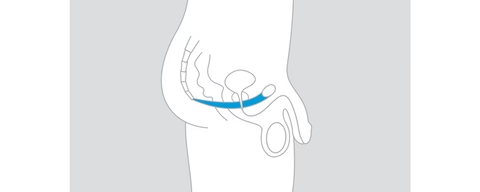The Connection Between Erectile Dysfunction & Kegels
Published October 11, 2025

Erectile dysfunction (ED) is probably the most common form of sexual disorder for men (over 50% of men between 40 and 70 years old in the US have issues with ED, and the rates are surprisingly high for younger guys too) and is certainly the most well-known, thanks largely to the millions of dollars spent by brands like Viagra and Cialis on advertisements over the past few decades. But it’s also just one part of a larger landscape around erections; there are lots of guys who don’t fall under the clinical definition of ED but who are still interested in better erections (e.g. more rigidity and durability).
In this article, we’re covering some of the approaches for dealing with ED and/or improving erections more broadly. We’ll focus particularly on pelvic floor (aka Kegel) exercise, since there is a growing body of evidence that Kegels can be an effective tool on the road to better erections (and better yet, men can do them privately, without risk of side effects).
What Solutions Are Out There?
There are a few options that have been fairly common over the years (besides Kegels; we’ll look at those separately further down).
Drugs
It’s probably fair to say that the vast majority of men are aware of ED drugs; the two most well-known are sildenafil (sold as Viagra) and tadalafil (sold as Cialis). They are both vasodilators, or chemicals that promote increased blood flow by widening blood vessels. They address ED specifically by blocking an enzyme called phosphodiesterase 5, which regulates blood flow in the penis.
The “little blue pill”, also known as Viagra (sold by Pfizer).
They work well (that’s why Pfizer has made over $30B in sales from Viagra since 2000) and can be a great solution. But they’re not a perfect solution – they come along with some common side effects (e.g. headaches or heartburn) as well as some more rare but serious side effects (e.g. vision problems or priapism that can damage the penis – that’s the “if your erection lasts longer than 4 hours…” disclaimer you may remember from the commercials). Plus some guys just prefer a non-pharmaceutical solution for their bodies if they have a choice (plus it avoids the ongoing cost of continually ordering more pills).
Devices
Limitations associated with pharmaceutical solutions is one reason that there are a number of ED devices out there. Some wearable vibrational devices do have research confirming their benefits, particularly for specific use cases like erectile dysfunction after prostate cancer or psychogenic ED. But many (like a number of pumps and rings designed to restrict blood flow) lack peer-reviewed scientific evidence of efficacy.
Psychological
It’s obvious that there are both physical and mental components to attraction and to sex. In keeping with this, there can be a psychological component to ED for some men (although in other cases it can also be a purely physical issue). And even if the root cause is physical and not psychological, there is a growing body of evidence that various mental therapies can be helpful to men with ED.
These frequently fall under the umbrella of Cognitive Behavioral Therapy (CBT) or sex therapy, and the research in this area is quite interesting. One study found that ED has some degree of psychological component for about half of men in general, and the number is even higher (70%) for men with ED under the age of 40). Those researchers also found that drugs like sildenafil are less effective than usual for men whose ED has psychological components, but that CBT was a promising treatment. Lastly, researchers have found that different methods can complement each other well; for instance, this study found that CBT + medication worked better than either CBT or medication on their own.
Overall, these therapeutic approaches have a lot to recommend them, since there are no side effects and they can often be pursued privately, but the one main drawback is that for many men, ED is a purely physical issue and in those cases, they aren’t able to help.
What About Kegels?
That is where Kegels can come in, as they have the potential to provide a no-side-effect option that can address the physiological side of ED.
How Is The Pelvic Floor Related To ED? Do Kegels Actually Help?
The pelvic floor muscles (specifically the bulbospongiosus and ischiocavernosus) play a large role in regulating blood flow into and out of the penis and thus help control rigidity of the erection. In fact, research has shown that guys with ED can’t voluntarily activate their pelvic floor muscles as well as guys with normal erectile function.
The pelvic floor (in blue) is a hammock of muscles, ligaments and other connective tissue at the base of the pelvis that plays a large role in erections.
That is further supported by research that has looked specifically at the effect of pelvic floor exercise (Kegels) on men with ED. This study found that “pelvic floor muscle exercises and biofeedback are an effective treatment for men with erectile dysfunction.” Other studies have found similarly encouraging results; put it together and this meta-review (which assessed 37 separate studies that looked at pelvic floor exercise as a treatment for sexual dysfunctions including ED) concluded that, because pelvic floor exercise is simple, safe and noninvasive, it should be “a preferred approach in the management of ED.”
There is also one other thing to note from that last paper. The authors wrote that it is important to avoid hyperactivity/increased tone of the pelvic floor muscles. This is a great point – put more simply, some men have pelvic floor muscles that are overactive / too tight, and this can lead to pelvic pain or other issues. It is also possible to develop overactive pelvic floor muscles if you do too much Kegel exercise (as with any other type of exercise, it’s possible to overdo it). So, if you have pelvic pain, Kegels are not the right approach, and you should be mindful about how aggressive your Kegel exercise regimen is (5-10 minutes per day of Kegels is usually plenty). The other limitation is that, although the pelvic floor plays a large role in controlling erections, it is not the only factor. So Kegels are not guaranteed to work for every guy (but literally nothing is). Overall, however, the evidence is clear that pelvic floor exercise can be a useful tool for guys with ED, either in combination with mental / therapy approaches or just on its own.
How Do You Do Kegels?
The obvious follow-up question is, how do you actually do Kegels? It’s very straightforward. Visualize peeing and then picture which muscles you would use to stop the flow of urine mid-stream (without using your hands). That muscle contraction you just imagined (or maybe actually performed) is a Kegel and the muscles you used are your pelvic floor muscles. You can also think about trying to avoid passing gas at the same time, and about what it would feel like to squeeze and lift the muscles you’re using. Pelvic floor exercise is just doing Kegels over and over (and over and over); there are lots of ways to vary how hard you’re squeezing, how long you’re holding the squeeze, how quickly you’re squeezing, and other aspects of the exercise but the core concept is quite straightforward.
In fact, it can be a bit too straightforward sometimes. One of the biggest drawbacks of pelvic floor exercise is that a lot of men find it difficult to stick with a consistent routine because it’s so boring. Imagine trying to work out another part of your body by just flexing and then relaxing those muscles again and again and again – doesn’t sound like the most entertaining workout experience, does it? That’s where a tool like Boost can come in – Boost is a Kegel exerciser for men that is designed to make Kegels easier, more fun, and ultimately easier to stick with (after all, the benefits of Kegel exercise that have been covered above can’t be unlocked unless you actually do the exercise regularly).
It provides biofeedback (to help you know whether you’re doing the exercises correctly), exercise history data (to quantify and track your progress) and guided workouts / games (to help you get a balanced workout that isn’t boring). And, in contrast to many of the other tools for measuring men’s Kegels, Boost does not use a rectal/anal probe to measure your pelvic floor muscle activity – you just place it on a chair and sit on top like a bicycle seat, with clothes left on.
The Bottom Line
Erectile Dysfunction (and the desire for better erections more generally, even if you don’t have ED) is an extremely common issue. Drugs (Viagra, Cialis, etc) do work well but have potential side effects. For men who prefer a non-pharmaceutical approach, research has shown that Kegel exercise can be an effective tool to achieve better erections, whether or not you have ED (particularly in combination with CBT or sex therapy programs to address any mental factors that may be contributing). And especially since you can do it privately and at home, with a minimal side effect profile, it’s definitely worth considering.









